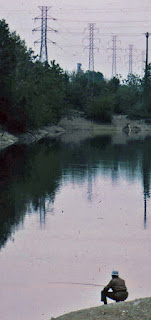 |
| James Osborn, Russell Springs, KY |
It's development was a joint effort of the National Fish Hatchery, a division of the U.S. Fish & Wildlife Service and the Kentucky Department of Fish and Wildlife Resources. The funds for the project were by Kentucky Wetland and Stream Mitigation Fund Trust. No tax monies, revenue from fishing licenses or state general funds were used by the departments.
Wolf Creek Dam is one of the series of flood control and electrical power producing dams of the 1930s, 40s, & 50s. It forms Lake Cumberland which has more miles of shore line than the state of Florida. The huge lake is a mecca for water enthusiasts and fishermen located in South Central Kentucky near the Tennessee border.
One angler described it as the most peaceful spot in Russell County and assured me that he headed out to cast a line every chance he got.
The 'old creek' was a bare banked run-off ditch carved in the terrain by drainage following an elevation drop from Wolf Creek Dam to the Cumberland River. Over the years silt, debris, and alien species of vegetation chocked the little gully dumping fine soil into the river.
Astute planning backed up with extensive knowledge of trout habitat allowed the personal and their volunteers to construct man-made glides, still pools, eddies, runs, bank overhangs, and environmentally safe plant species to recreate a 'natural' home to stimulate fish behavior and to foster spawning cycles of wild trout. 18 million gallons of water moves daily through this sylvan area duplicating the rush and rambling spill of nature's aqua purifier required by rainbow and brown trout for survival.
Walking along the waterway or down the nature trail it's difficult to conceive a fall of 47 feet in elevation. Calves would be screaming and breath would be short if the pitch only covered the length of the Upper Reach of Hatchery Creek instead of a distance of 'give or take' a mile of the Lower Reach.
At the Upper Reach of Hatchery Creek there is a creel limit of five fish per/day. Watching from above it reminded me of TV shots of hopeful fishermen casting their lines from bridges and causeways.
The Lower Reach of the creek is 'catch and release' using artificial flies. Both areas of the creek require a KY trout permit. Fishing the Lower Reach is a day of testing one's skill with a fly rod & reel and untangling a line caught on a bush. As a river rat says to a novice to the ancient sport of fly fishing in our forthcoming novel, "Fishing ain't for catching fish. It's for con . . . tem . . . plating."
The location of a National Fish Hatchery in Russell County, Kentucky has survived being tossed around for closure as a political football on numerous occasions due to the hard work of many citizens. I remember collecting signatures and even a few marks on petitions for the notice of 'powers that be' to voice opposition to political maneuvering.
Hats off to the foresight, ingenuity, educational efforts for both children and adults, and dedication of the employees of the National Fish Hatchery for maintaining a heaven on earth for trout fishing. It will take a few years to grown and develop into a truth wetlands habitat, but even now all the practitioners we met on our walk were avid fans.
The photo is of James Osborn, manager of Woodies Restorations in Russell Springs, KY who continues to enjoy fly casting as he was taught by his grandfather.



